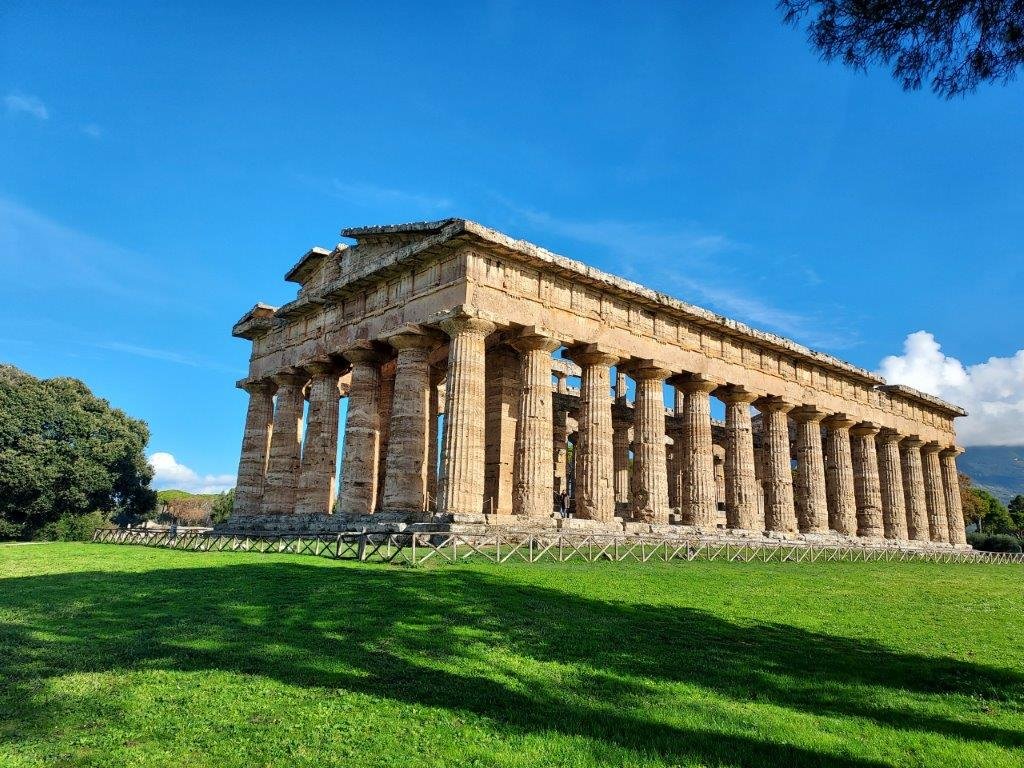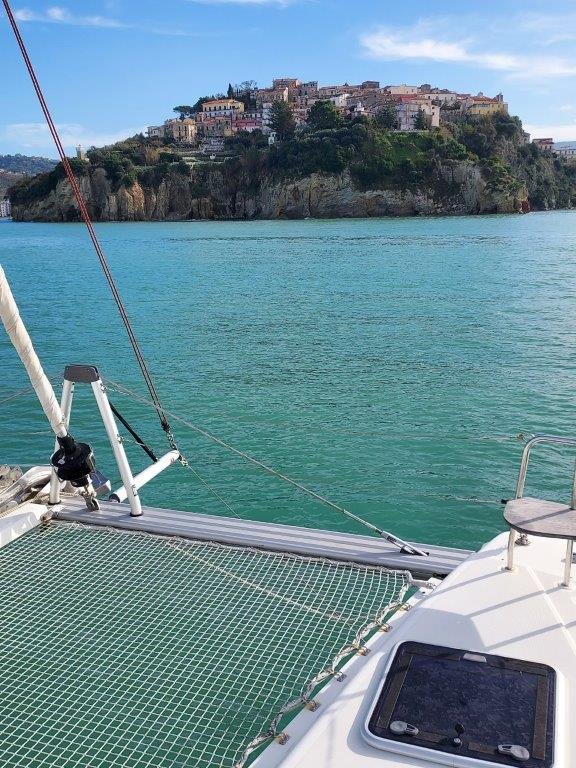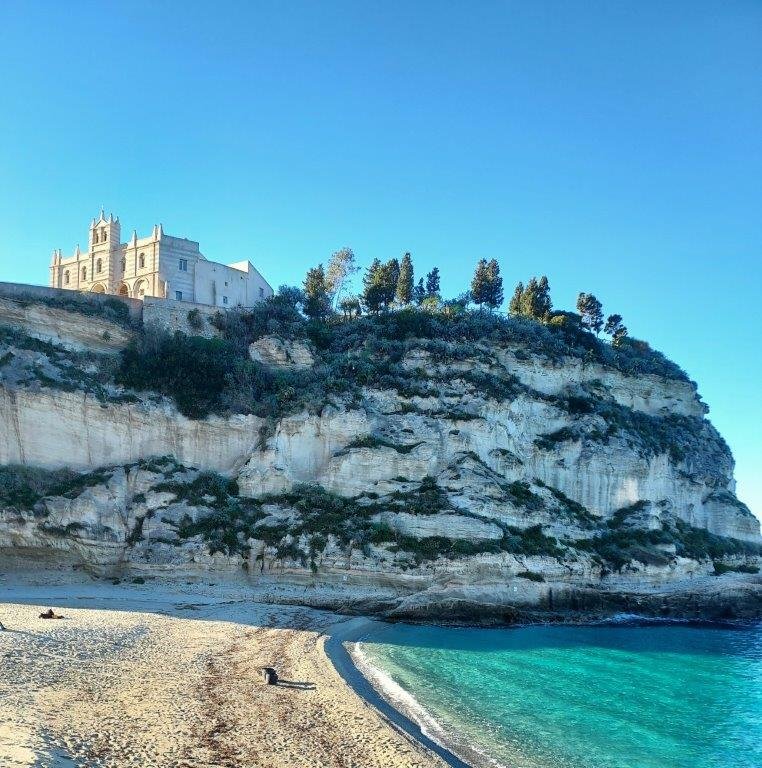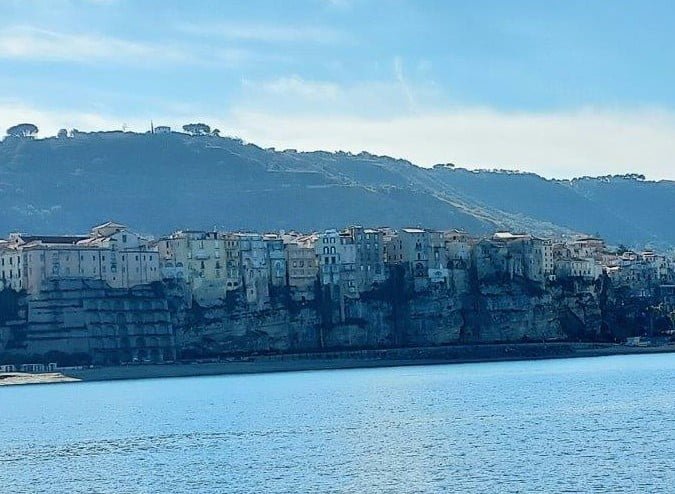We started to sail the southernmost region of the Italian mainland, called Calabria. It is perhaps the most unspoiled region of Italy, with mighty rocks rising out of the sea and very clear water.
This is the last part of the southeast coast of Italy that we are going to sail, before we make the crossing to the island of Sicily.
These are the places that we visited in December on and above the ‘boot’ of Italy:

Paestum
As we sailed further south, we noticed that the influence of the ancient Greeks is increasing. The Greeks were developed earlier than the Romans and due to the prosperity in their empire, the Greeks sought expansion, resources and crossed over to the south of Italy. The founding of the town of Paestrum (originally called Poseidonia by the Greeks) is a good example of this.
The colony owed its development in the 7th century BC to a favorable geographical location at a crossroads of trade routes between the Greek and Italian spheres of influence. The city was called Poseidonia, after the sea god Poseidon, to honor the fact that the sea the Greeks sailed became a source of the Greeks’ prosperity.
Here you see me standing in front of 1 of the 3 remaining temples, named after the Greec goddess Hera.

The city flourished, especially from 550 to 400 BC, but in 273 B.C. the Romans occupied Poseidonia and changed the name to Paestum. The city remained in continuous use during the Roman imperial period, but began to decline in importance from the 4th century AC onwards, due to several causes.
The deforestation of the neighboring mountains (for economic and military purposes) caused silting and drastically changed the river basin. That encouraged swamp formation, so malaria began to undermine the health of the residents. Moreover, the construction of new roads, which connected Rome more directly to the East via the Adriatic Sea, had made Paestum less attractive as a traffic junction.
I find all these factors so interesting to know: how decisions of man and their influence on nature, made a once flourishing city forgotten for centuries! Because after shrinking into a meager village, Paestum even was completely abandoned during the Middle Ages after the inhabitants fleeing the malaria and pirates, moving into the neighboring mountains in the 9th century,. After its demise, Paestum was only mentioned by historians and poets, who mainly referred to its beautiful roses, bifera rosaria Paesti, which bloom twice a year.
The ruins only came into the spotlight again in 1752, because after the rediscovery of Pompeii and Herculaneum. Italians wanted to see these old Roman cities and roads were built, bring out the ruins of Paestum.

The temples were in good shape, for instance the temple of Athena had a lot of artifacts like vases and jewels, that we later saw in the museum at the border of the city. There was also a small amphitheater where gladiatorial shows were held with fights and exotic animals. And sometimes people could watch in the amphitheater executions of individuals who had been condemned to death.

Outside of the ancient Paestrum, in the modern city now, there was a bench where they repainted the most important building of old Paestum that was remained the best, the temple of Hera. It showed what it must have looked like with all the original colors of white, blue and red. Really nice to see!

Agropoli
We sailed further south and ended up at the city of Agropoli, the old village is beautifully situated on a hill.

It was nice to cycle around in the city and see all the Christmas decorations and the old fishing harbor.

During the festive month you see people do a lot of shopping for presents and food. And we noticed in the supermarket these big carton boxes with a cake in it. It turned out to be the popular ‘Panettone’, a kind of round, high cake, filled with fruits, candied peel and raisins.


We bought one, because we were curious what it would taste like. In Holland in December, we have apple turnovers, apple fritters, Christmas wreaths and of course ‘oliebollen’. Italy has panettone which has long been the traditional December pastry of Milan. In recent years, panettone has conquered all of Italy. Italians eat it for breakfast or with a glass of Prosecco later in the day.

As with many traditions in Italy, the panettone is often prepared yourself and given as a gift to friends and relatives. In Italy you run the risk of still being stuck with a large number of panettoni after the holidays. But the Italians wouldn’t be the Italians if they hadn’t invented a new tradition around this.
On February 3, the day of San Biagio, the leftover cakes are devoured en masse. Bakers follow tradition by baking new panettoni prior to this date, so that you run the risk of getting one again. Of course you will never get rid of it that way!
Camerota
We left Agropoli (with a least 3 panetonnes on board 😉), and continued sailing along the beautiful coastline. The steep hills and colorful houses built against the mountainside continue to delight me!

The southeast coast of Italy is quite long and not as dense populated as the Bay of Naples. So there are less marinas and some are also closed during wintertime or are too small for catamarans (we also don’t see catamarans a lot anymore).
When I scanned the Navily app, which shows all the harbors and anchoring spots in the Med, I noticed the Marina of Camerota. Big enough for our ship and open this time of year, but like many harbors in Italy quite expensive (€ 100 to € 200 per night in December!).
I was not happy with that amount, but when I clicked on a harbor sign next to this big marina, I suddenly saw the words ‘Free Quay’. It turned out that a sheltered corner in the marina of Camerota was free for boats to stay for 3 maximum days. No water and no electricity, but you were allowed to tie up our boat to the quay. Then you just had to go to the nearby office of the Guardia Costiera (national coast guard) and register.
We don’t know why they offer this free quay, we assume that some municipalities in the south of Italy have to offer this kind of service, because boaters in distress or after a long crossing from Sicily for example, need a place to stay.
So we took the long sail to Camerota (8 hours) and reported at the office of the Guardia Costiera, arrving just before it started to get dark around 16.30h. Like all ‘marinas, the staff need a copy of insurance papers for the boat, ownership papers of the boat, passports of the crew and after 15 minutes it was ok, we got a small paper (like a parking ticket for your car, to put behind the windscreen 😉), which apparently gave us permission to stay a the quay for 3 days.

As a bonus, we discovered that the city was quite charming with small streets and friendly residents.


The second day, we went out for dinner and when I googled for a restaurant I saw the odd name of ‘Guacamaya’s’ which was a Venezuelan restaurant. We went there, curious, because we thought it was a bit strange to find this kind of food in Italy 😉.
It turned out that a father and son run this lovely and fine restaurant. Their grandfather moved to Venezuela end of the 19th century, when the south of Italy suffered from unemployment, poverty and some Italians were seeking happiness in the Americana’s. The father returned to this elderly house in Camerota and turned it into a small restaurant with 10 tables with the Venezuelan dishes he grew up with. He was such a friendly person and they both served us great food, so we were very happy to have stopped there!

Maratea
The next stop would be Maratea, the port was spectacular, because it had the backdrop of a high mountain side. Here you can see our catamaran in the harbor:

We cycled up the steep hills with our e-bike and e-step to see the views, and noticed again a lot of citrus orchards and also a lot of religious figurines of Maria in houses and buildings.


The view on the harbor from above was great:

Cetraro
On the boat, Gilles and I divide the daily work according to our talents and things we like to do. So Gilles is more technical, likes to trim the sails and do the navigation. I like to organize, so seek out harbors, contact harbormasters, selecting cities and sightseeing.
So for the next harbor I choose Cetraro, but I mentioned to Gilles that there were ‘warnings’ from other sailors that there was a lot of sand formation at the entrance of the harbor and depths were reported from 1 to 2 meters maximum in the Mediterranean Almanac that I use for nautical advice.

Our ship has a draught of 1.30 meters, so that might get tricky. When you sail, you always have to have plan B (and C) when it comes to your overnight stay (in a harbor or at anchor), because you have a floating house which has to be in a safe environment during the dark of the night (also visible for other boats!).
Plan B was anchoring next to the harbor of Cetraro, in the Navily App (source number 2 that I use) there were good reviews about this spot (depths of 5 meters, not a lot of swell with these westerly winds, a sandy bottom so good holding for our anchor.
It was Sunday when we entered the harbor, no staff around and Gilles sailed into the harbor at a leisurely pace. I kept checking the depth meter while Gilles checked the rocks and staying in the middle of the entrance. The depth quickly dropped from 5 meters to 3 meters to 2 meters. A young man stood at a quay near the entrance shouting at us: ‘No, no!’, because many people think that a large vessel like a catamaran has a least a 2 meter keel or sword underneath the ship. But because our hulls take care of the stability of the ship, we don’t need lenghty keels. However our ship came to a stop: 1 meter depth. Gilles banged the engines and we turned around, thanking the young man and anchored next to the harbor 😉. Never a dull moment, when dealing with nature 😊.
Next morning on a Monday when we left, we noticed a brew busy dredging on the sandbank. And when I say ‘on the sandbank’ I mean this literally: the crane you see in my picture stands on the sand in the water!

Vibo Marina
We sank further and further to the coast of Calabria. The depths in this part of the Mediterranean Sea vary a lot: 20 meters to 200 meters to 1200 meters, in 1 minute sail of each other. That means the bottom has deep grooves. You can tell by the color of the water how deep it is (light blue is not deep).


We stayed 1 night in a small town called Vibo Marina, at Yacht Club Costa Viola, with the kind owner Sergio. He explained that the tradition of his marina was that boaters received a bottle of Prosecco for staying at his harbor, even if it was for 1 night. We thought this was so kind, so we asked him if you could take a picture with the three of us and the bottle of Prosecco!


Tropea
At this point of our trip, we are ‘on’ the foot of the boot of Italy. So we already can see the island of Sicily, also because it has higher mountains (up to 3300 meter) than Calabria (highest point is at the eastcoast here is 1900 meter).
Sailing from Vibo Marina towards Tropea, also showed the aeolian islands in the distance. This is the island group above the northeast tip of Sicilie. The nearest and highest island to us was Stromboli, which is also an active volcano. So we were about 60 kilometers away from Stromboli, sailing towards Tropea, and because of the clear skies, we could actually see smoke coming from the crater at the top of the volcano!


At first, we thought it was a cloud, but since it was very sunny, there were not much clouds 😊. Then the ‘cloud’ disappeared and another plume of smoke arose and grew. Seeing this process over and over again, and looking with our binoculars, we concluded: Stromboli is active. And later in Tropea, a inhabitant explained to us: ‘Smoke at the top is daily and normal. When there is no smoke, that’s when you have to watch out! Because then a ‘chimney’ collapsed inside the tube and pressure of the gas starts building up which may lead to an eruption’.
We arrived at Tropea, with Stromboli in the background. It is a picturesque village and in 2021 it was named one of the most beautiful villages of Italy, or in Italian: ‘Il borgo dei borghi’ from the national list ‘Borghi più belli in Italia’.
One of the highlights of Tropea (literally!) is this church on top of the cliff, called ‘Santuario di Santa Maria’. The crystal clear water and the palm trees around it make the position of the church even more special.


The municipality of Tropea made a real festive atmosphere in their village this December with a lot of Christmas decorations.


So after visiting the village in the afternoon, later that evening we walked back again from the harbor up the hill, to see the city with all the lights!



Next morning we sailed of, and sailing along the town, you could see the high cliffs that Tropea is built upon.

Palmi
Palmi would be our next harbor, just for 1 night. It was a big harbor and what I always like to do is walk around to check out other catamarans, Dutch boats or other sailors to talk to. There were not many catamarans (like I explained) and because of winterseason, many travelers leave their boat in the harbor and go home for 5 months. But it’s also to look at different boats and how international the ‘fleet’ of cruisers is! Just a few pictures I took, walking around on the jetties in this harbor:

We heard about the good cuisine from Calabria, sailing along the coast, so we wanted to try that out! We also noticed that, like in Sicily, the southern part of Italy is more unpolished, simple, rough and looks a bit shabby sometimes. But the food is great indeed. So the saying ‘don’t judge a book by it’s cover’ absolutely applies to restaurant building and the food being served here, because it was delicious!
Italians are so great at making pasta’s and pizza’s! All fresh and especially at the coast the fish is great. Don’t ask for meat or chicken, because they mess it up, overcooked, so you will find it more like the ‘shoe sole of the boot’ 😉. So always go for pasta or pizza on the menu.


The total price of our 3 meal course at Palmi, including bread, desert, a bottle of water and wine was € 78. In the Netherlands we would have paid at least € 120 for 2 people. We talked about that great food all evening and almost felt sorry we didn’t book 2 nights at this harbor 😊.
Villa San Giovanni
Our last stop at the mainland of Italy (for now), would be Villa San Giovanni. That means, we turned the corner, and are now at the ‘toes’ of the boot of Italy.

Italy is a very religious country, we saw again the images of Maria and saints in the harbor. It gives me a protected feeling. And I also notice it more now, because it’s applicable in this time of year.


In the harbor of Villa San Giovanni we planned our crossing to Sicily. Although the point we wanted to cross is ‘only’ 3 kilometers wide, you need to plan, because the Street of Messina, the water between Sicily and the mainland of Italy, is busy with ferries, containerships and other vessels. And we have to do some research to get to know these waters (current, tide, depth, shipping lane, etc). More about our crossing to Sicily in the next blog, where we had our X-mas celebration on mount Etna!





